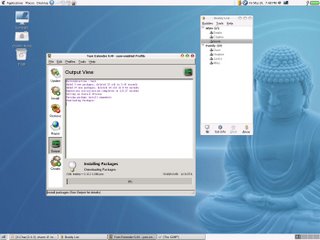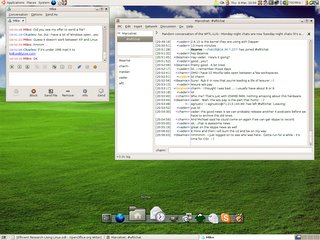In an IRC chat: irc:chat.marcelgagne.com, Marcel Gagne, Linux Journal columnist, and author of multiple books on Linux, directed chatters to a Forbes article in which Microsoft CEO Steve Ballmer talks about how he *might* attack Linux claiming a violation of Microsoft patents.
From the first sentence the article is clearly skewed in Microsoft's favour, but hey, we're talking Forbes, "HOME PAGE FOR THE WORLD'S BUSINESS LEADERS." I don't think the concept of "free as in speech" is in their vocabulary. But, back to the first sentence which begins "Fans of the popular Linux software program have long fretted that software giant Microsoft will attack Linux by claiming the free program violates Microsoft's patents." It's a pretty long and loaded sentence.
Starting with the first word, Fans, Forbes portrays Linux users as not being serious, they're just fans. Fans are associated with fun things like sports. Hey, Linux is fun, but there's definitely a serious side, Linux's use in the enterprise is a testament to the fact that there's a very serious side to Linux.
The second problem I have with the sentence is that it claims Linux users have all been worried about Microsoft attacking Linux on the basis that "the free program" violates Microsoft's patents. First, who's worried? I certainly haven't been worried about Microsoft attacking Linux. They haven't been successful attacking Linux through SCO, and now that there is an investigation underway looking into the relationship between SCO and Microsoft the Forbes article looks suspiciously like an attempt to redirect people's attention away from the investigation. Let's be clear, if the courts prove a Microsoft/SCO connection the result could further damage Microsoft by re-opening the monopoly can of worms. The other part of the sentence which is bothersome is the diminishing of Linux as "the free program." Technically speaking, Linux is a program - the kernel. But the article makes no reference to the kernel, and other parts of the article imply that Linux is a collection of programs.
The second paragraph implies Linux is the whole collection of kernel + 3rd party programs, "Right now, I can go out and get a free alternative to just about every product Microsoft sells." So which is it, a program, or collection of programs? Apparently the article author thinks it's either depending on how he can frame Microsoft in a positive light. Ballmer responds to the "why buy Microsoft, if you can get a free alternative" by implying Microsoft software does more. Anyone who has ever installed a Linux distribution like Fedora, Mandriva, Slackware, or Debian, knows the all mainstream Linux distributions come with a lot more software than Microsoft Windows, and are much more capable out of the box. I don't have to purchase add-ons to run a database server, and my office suite doesn't cost me an extra $650 CDN for the version which includes a graphical database. Let's also look at the example of Firefox versus IE. With its extensions, tabbed browsing, and regular development cycle, Firefox does a lot more than IE, and will continue to do so in the future.
Ballmer continues his response for three paragraphs near the end of which he says, "Put the courts aside, we have a lot of competition." Notice the careful redirect, "put the courts aside." Microsoft certainly has done that in the past, and they clearly want the public to forget they're a monopoly while permitting them to attack competitors using monopolistic tactics.

